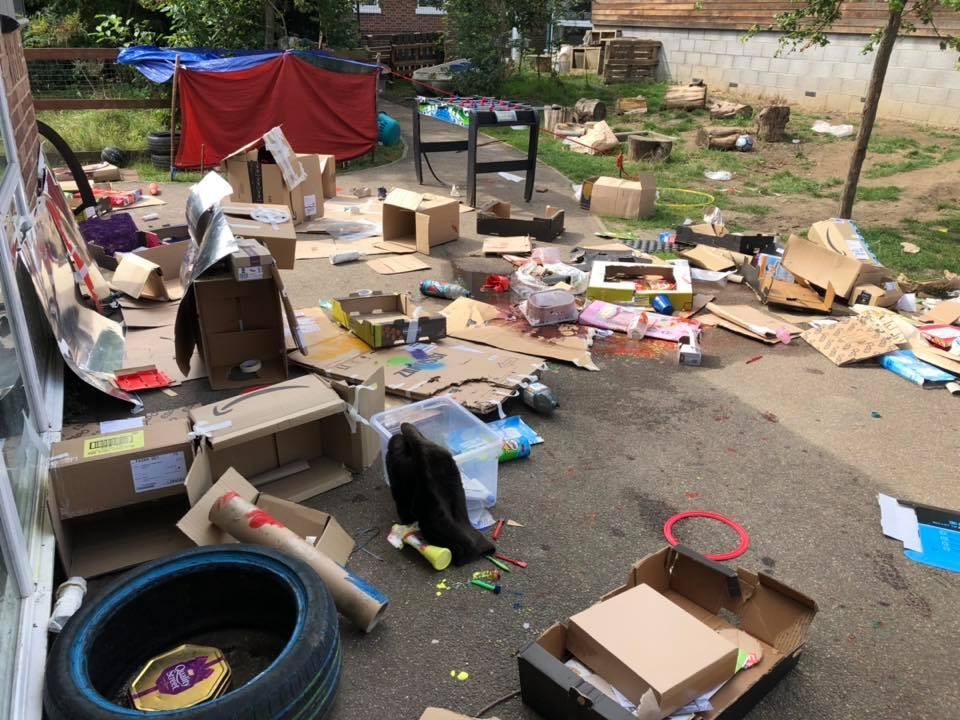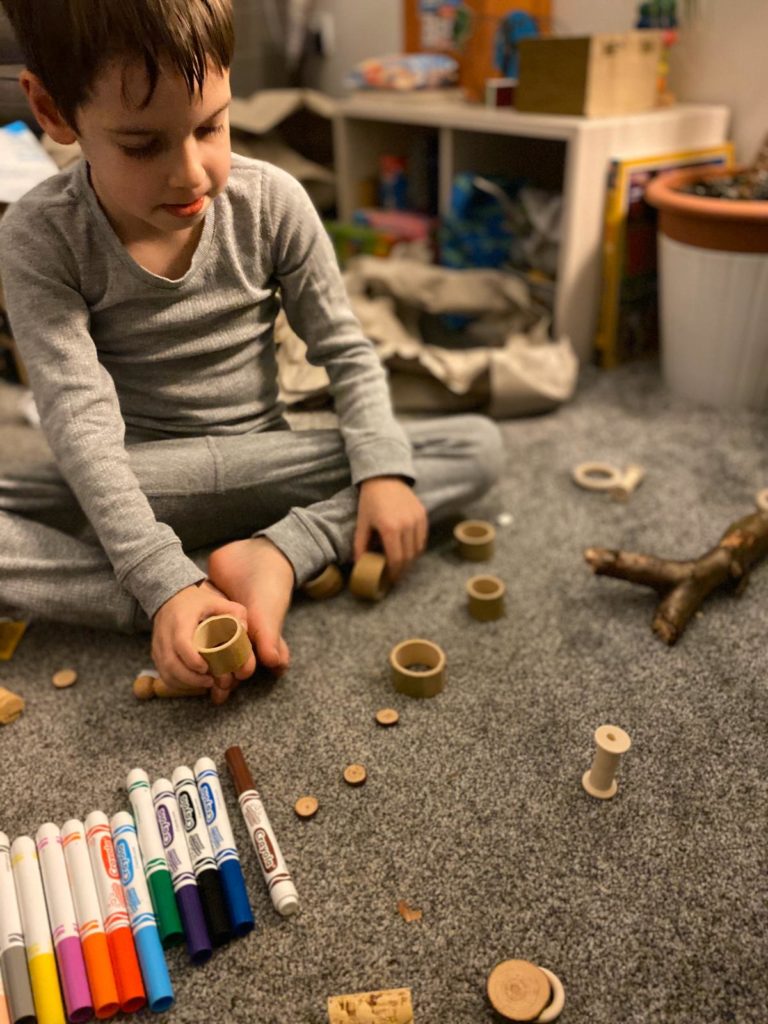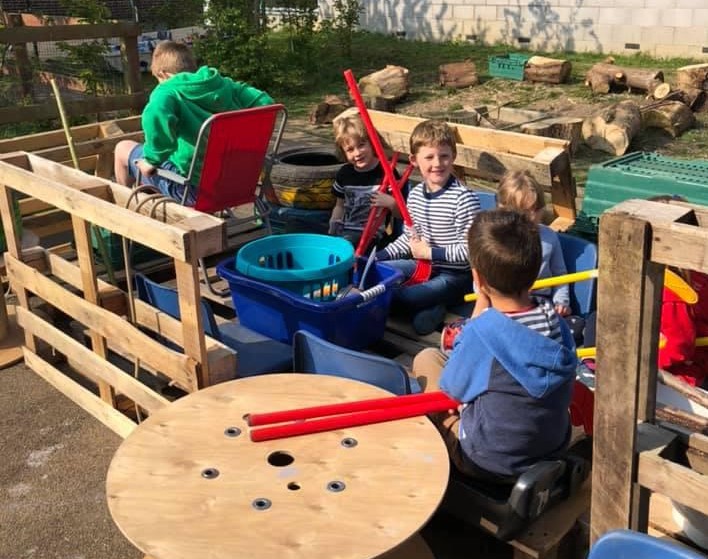Loose Parts at Smartkidz

Have you ever wondered why children can spend hours sitting in an old box when there is a pile of new toys waiting in the corner? Or, why you have to empty piles of sticks and stones from their school bag?
The reason for this is closely linked to an approach to play known as ‘loose parts’. At all Smartkidz locations, loose parts are a driving force in how we set up our play spaces. In this article, we will introduce you to the ideas of loose parts play, explain why it is so essential to children’s development and set you a challenge to try at home.
What is Loose Parts Play?
Loose parts play is a type of play that uses and builds on imagination and invention. It encourages children to challenge themselves and take risks in ways that other types of play can’t.
It is defined by the resources that children can access during play. Instead of using purpose-built toys like cars, figures, plastic food and board games, it revolves around items that are open to interpretation like logs, sticks, shells and feathers.
Why Is Loose Parts Play Important for Children?

It engages their imagination
Objects with no previously defined role or rules give the opportunity for imagination to take over. This is what is happening on Christmas day when your children are sat happily in the box their ride-on toy car came in.
While a toy car lends itself to be played with like a car, a box offers thousands of play opportunities. With a little imagination, it can become anything from a train or car to a toy kitchen or even a shopping trolley.
Children can interact with their wider environment
Not only do loose parts allow for imagination concerning the object itself; it also enables children to design constructions that can expand into their environment. They can be used for designing and building in ways that many specific toys can’t.
For example, when you play with Lego, you are learning the rules of Lego. You gain an understanding of which bits stick together and how to build with them. With loose parts, you aren’t learning the rules of a toy, you are learning the rules of the world around you.
Loose parts provide an understanding of authentic materials that can be applied to thousands of real-life scenarios. How tall structures can be built, how bridges carry weight, where your centre of gravity is, what happens when something falls, and what happens when you remove items from a tower.

They provide open-ended play experiences
An open-ended play experience is one where the resources available open up the play opportunities.
For example, a child playing with a toy kitchen has a limited number of options in their play. However, a child playing with a log offers thousands of play opportunities. It can be used as anything from a snake slithering around on the floor to a witch’s broomstick to fly away on or hundreds of other things. When an open-ended opportunity is provided it encourages children to use their imagination and to be more physically active in their play.
Loose Parts Play at Smartkidz Play and Learn Settings
In all our settings, you will find loose parts. They can be anything from planks, ropes and milk crates to wooden pegs, wooden hoops and corks.
We are always adding more items and they are usually added for one of three reasons:
- Because we find something interesting that we think might be an excellent loose part.
- When we see the need for something a particular type of object.
- Or when children request something specific for their play.
If we followed the same process with standard toys, they would probably be used for their intended purpose just a handful of times. But with loose parts, the original purpose is forgotten or was never there.
If we provide something for a specific purpose, once it is blended with our children’s imagination, it becomes something even better. Then that object becomes beautifully linked to that person during the time it’s being used.
Five minutes later it could be something incredible for someone else, but at that moment a piece of wood is the best toy in the world.
Loose-play areas or loose play kits
Occasionally we focus on building loose-play areas or create loose-play kits. When children first see them, there isn’t the immediate visual impact that some fresh out of the box toys can have.
With loose parts, the fun is slow-building but longer-lasting. At first glance, children often appear to see the objects as we do ‘its just some wood’, ‘that’s boring’ ‘where are the toys?’
But with a little time and imagination, something truly magical happens. It often starts with a look of intense concentration and then as games and stories blossom in their head, the smiles begin.
After a while, no pre-purposed toy could drag their attention away from a pile of sticks and some old cotton reels.

Making Loose Parts Available at Home
At Smartkidz we have lots of space and lots of people to donate mysterious and exciting objects. However, to create your stocks of loose parts at home doesn’t take lots of energy or hundreds of pounds. Setting up a fantastic array of loose parts can be done for a fraction of the cost of many modern toys.
Loose parts can be anything that will spark the imagination; they can be natural objects like sticks and pebbles or synthetic items like packing material or old circuit board.
To get you started here is a list of some things that have worked well in the past for us:
Water, sand, dirt, sticks, branches, logs, driftwood, grasses, moss, leaves, flowers, pinecones, pine needles, seeds, shells, bark, feathers, rocks, stones, balls, hoops, rope, tyres, water, straw, buckets, cups, containers, digging tools, chalk, scarves, ribbons, fabric, blocks, building materials, pouring devices (cups, spoons, buckets, funnels), blankets, fabric, floor samples, sensory materials, recycled materials (paper tubes, papers, ribbons, bottle caps, lids, wood scraps, wire, foam, cardboard), plastic guttering, tools, art materials, buttons, spools, natural and coloured lolly sticks, beads, straws, paints, brushes.
These are only ideas to get you started; a loose part can be anything that will inspire open-ended play.
Conclusion
Loose parts play is one of the best value experiences you can offer your children. As with anything excellent, it may take time to reach its full potential, but it is well worth persevering. Why not try collecting some loose parts of your own and post the pictures to our Facebook page?
Create your loose parts box and have it accessible and free to use in your house. Then see what interesting and extraordinary things you can find to go in it. Going out and finding them can be an adventure in itself.
